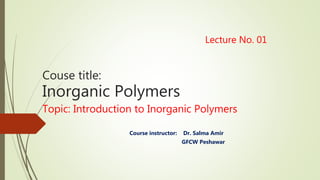
Introduction to inorganic polymers by Dr. Salma AMIR
- 1. Lecture No. 01 Couse title: Inorganic Polymers Topic: Introduction to Inorganic Polymers Course instructor: Dr. Salma Amir GFCW Peshawar
- 2. Introduction Polymer chemistry impinges on nearly every aspect of modern life, from electronics technology, to medicine, to the wide range of fibers, films, elastomers, and structural materials on which everyone depends. Most of these polymers are organic materials. By this we mean that their long polymeric backbones consist mainly of carbon atoms linked together with covalent bonds. Organic polymers are derived either from petroleum or from plants, animals, or microorganisms. Hence, they are generally accessible in large quantities and at nominal cost. It is difficult to imagine life without them. After this much discussions the question comes in everyone’s mind that Why, with the hundreds of organic polymers already available, should scientists be interested in the synthesis of even more macromolecules?
- 3. Introduction Of Inorganic Polymers Inorganic polymers by looking its name one can say that they are nonorganic or non-carbon containing polymers. The most obvious definition for an inorganic polymer is a all covalently bonded macromolecules with a skeletal structure that does not include carbon atoms in the backbone. Polymer that has inorganic repeating units in their main polymeric backbone are known as inorganic polymers. It is a giant 3D or 2D network structure made up by number of covalent bonds but with an absence or near-absence of hydrocarbon units in the main molecular backbone. Covalently-bonded crystals (e.g., oxides and halides), condensed phosphates etc., are the examples of inorganic polymers. These polymers possess distinctive physico-chemical characteristics and unique physical, mechanical and electrical properties. These polymers are of extensive utility in everyday life, particularly in the area of engineering and technology.
- 4. Reasons for interest in inorganic polymers Drawbacks associated with organic polymers Many organic backbone polymers react with oxygen or ozone over a long period of time and lose their advantageous properties. Most organic polymers burn, often with the release of toxic smoke. Many organic polymers degrade when exposed to ultraviolet or gamma radiation. Organic polymers sometimes soften at unacceptably low temperatures, or they swell or dissolve in organic solvents, oils, or hydraulic fluids.
- 5. Advantages of inorganic polymers Inorganic elements can have different valencies than carbon, and this means that the number of side groups attached to a backbone may be different from the situation in an organic polymer. This will affect the flexibility of the macromolecule, its ability to react with chemical reagents, its stability at high temperatures, and its interactions with solvents and with other polymer molecules. The bonds formed between inorganic elements are often longer, stronger, and more resistant to free radical cleavage reactions than are bonds formed by carbon. Moreover, the use of non-carbon elements in the backbone provides opportunities for tailoring the chemistry in ways that are not possible in totally organic macromolecules.